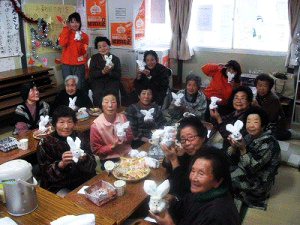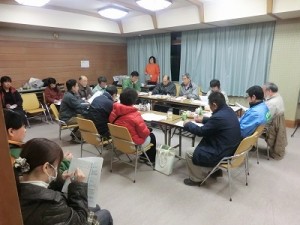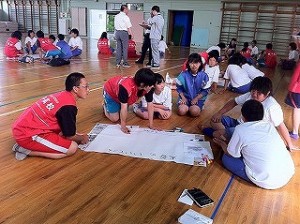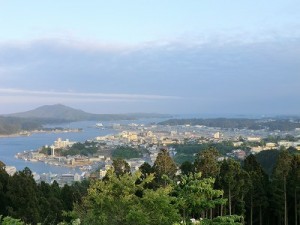Project Overview [Tohoku]
Background
While the Great East Japan Earthquake of 11th March 2011 was covered as a major incident by foreign media, information regarding activities of Japan-based aid organizations or support needs was reported only in Japanese even online. Hence, as an initial response, SEEDS Asia put together reports in English on the situation of affected areas for non-Japanese speakers inside and outside Japan.
In addition, from 1st to 5th April 2011, joint needs survey was conducted in 12 towns and cities in the coastal parts of the affected area of Iwate and Miyagi prefectures, with OYO International Corporation and Kyoto University.
In April 2011, people started moving into temporary housings in affected areas. In the case of the Great Hanshin-Awaji Earthquake (1995), because most temporary housing sites were far away from where they used to live, and the residents were selected by lot, communities which had existed before the earthquake got fragmented. Consequently, they lived in isolation, and tragic incidents happened, where they died alone and were not found for a long time.
To be fair, residents of temporary housings were selected by lot also in Kesennuma City, Miyagi Prefecture, one of the affected areas of the Great East Japan Earthquake and Tsunami; consequently they had few acquaintances there. From the welfare perspective, activities to improve the livelihood of people in temporary housings were demanded; hence, such activity was about to be started by Kesennuma Reconstruct Association (KRA), established by the affected people for reconstruction of the area in April 2011. Since most employees of KRA did not have experience of conducting such activities, technical assistance (know how) was provided by SEEDS Asia.
Activities in Kesennuma City, Miyagi Prefecture
Community building support in temporary housing sites (joint project with KRA)
Since June 2011, tea parties have been held for all temporary housings in Kesennuma City, with KRA. At first, tea parties were held for residents of the housings to get acquainted. At the next stage, establishment of residents’ associations were subtly induced by telling them the following at tea parties: “If someone keeps the keys to common rooms in the site, this tea party will be held more easily.” “Residents’ associations will help aid organizations operate more efficiently.”
At the moment, tea parties has been held in coordination with the leaders of residents’ association in temporary housings.
In addition, for people stayed at their houses and did not participate in the tea party, recreational events have been held outside the temporary housing sites to promote more exchange, planned and conducted by KRA in cooperation with SEEDS Asia.
Exchange meetings for Leaders of Temporary Housing Sites (Joint project with Volunteer Station in Kessennuma (VSK))
Since winter in the Northeast region of Japan is harsh, temporary housing residents were worried about how to cope with cold weather. Some leaders of residents’ associations individually requested to officials of the city for possible measures, but no collective request had been made.
Therefore, exchange meetings for leaders of temporary housing sites in Kesennuma area was held, to figure out solutions together for challenges at each site.
Since the beginning of 2012, the exchange meeting has been held by VSK, a local CBO established after the earthquake, with management assistance by SEEDS Asia.
Assistance to DRR education/Education for Sustainable Development (ESD)
In 2012, SEEDS Asia and Graduate School of Global Environmental Studies, Kyoto University started assisting DRR education working group of the research-teachers from Kesennuma City Board of Education, including management assistance, technical advice, and study visit arrangement.
Also, DRR activities and community study have been conducted in integrated study at elementary and junior high schools in Kesennuma City with assistance of SEEDS Asia, including volunteer activities experience, exchange with residents of temporary housings, plus making and performing the drama based on the local folklore.
Furthermore, following educational visits has been conducted: Students of Environment and Disaster Mitigation Course of Maiko High School visited Kesennuma for exchange activities with local junior high school students; Junior high school students in Kesennuma visited Kobe to experience DRR education/activities based on lessons from the Great Hanshin-Awaji Earthquake.
Assistance to Recovery of Affected Communities with Participatory Method
After the Great East Japan Earthquake, significance of Kizuna (meaning bonds) was rediscovered. In 2012, SEEDS Asia has started activities to reunite people who used to live in the same communities before the earthquake.
In September 2012, the first festival after the earthquake was held in a community with assistance of SEEDS Asia. In 2013, a project has started for people, who used to live in the same community but now live in different places, to make memorial books together in order to remember the community destroyed by the tsunami, sharing information and opinion. In addition, assistance has been provided with revival of local culture such as traditional performing arts, by making drama.
About Kesennuma City, Miyagi Prefecture
Kesennuma city is in the Northeast end of Miyagi Prefecture along the Pacific Ocean and had a population of 70,000 in an area of 333km2 before the earthquake. The main industries of the city were fishery and tourism. The city has been known for one of the largest catches of tuna, bonito, and sanma (Pacific saury) in Japan, and had seafood processing industry complex from early times. The ria coast can be seen from the Karakuwa Peninsula to the center of Kesennuma.
Community building in Kesennuma city has been made, taking advantage of the food culture formed from the rich natural environment with mountains, rivers, and the ocean. In 2006, slogans were announced, “Kesennuma Slow Food” as well as “Fish Eating Healthy City” to promote health by eating fish. This way, Kesennuma citizens live in a close relationship to the ocean, and the fishery is considered as a main industry by the municipality for city planning.
On the other hand, Sanriku area including Kesennuma city is prone to tsunamis and had been hit by massive earthquakes several times in the past: “Meiji Sanriku Tsunami” of 1896 with 27,122 deaths; “Showa Dai Tsunami” of 1933 with 3,008 deaths; and “Chile Earthquake Tsunami” of 1960 with 119 deaths. *
The Great East Japan Earthquake and subsequent tsunami of 11th March 2011 devastated the city. In addition, the city center where many seafood processing companies were located was destroyed by the massive fire that spread from an oil tank at the bay entrance. More than 1,316 died or were missing, and 15,611 houses were destroyed, affected 9,500 households (as of 29th May 2012). Also, according to Kesennuma City officials, out of 4,102 registered business institutions, 3,314 businesses or 80% of the total were considered to be affected and local economy was devastated, led to a huge number of unemployed people.
* Kesennuma Chamber of Commerce and Industry, 2003, Marukajiri (complete) Kesennuma Guidebook (in Japanese)





